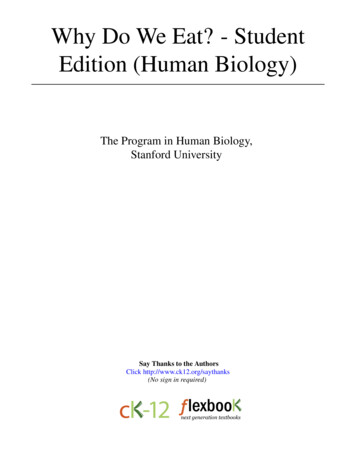
Transcription
Why Do We Eat? - StudentEdition (Human Biology)The Program in Human Biology,Stanford UniversitySay Thanks to the AuthorsClick http://www.ck12.org/saythanks(No sign in required)
To access a customizable version of this book, as well as otherinteractive content, visit www.ck12.orgCK-12 Foundation is a non-profit organization with a mission toreduce the cost of textbook materials for the K-12 market bothin the U.S. and worldwide. Using an open-content, web-basedcollaborative model termed the FlexBook , CK-12 intends topioneer the generation and distribution of high-quality educationalcontent that will serve both as core text as well as provide anadaptive environment for learning, powered through the FlexBookPlatform .Copyright 2014 CK-12 Foundation, www.ck12.orgThe names “CK-12” and “CK12” and associated logos and theterms “FlexBook ” and “FlexBook Platform ” (collectively“CK-12 Marks”) are trademarks and service marks of CK-12Foundation and are protected by federal, state, and internationallaws.Any form of reproduction of this book in any format or medium,in whole or in sections must include the referral attribution linkhttp://www.ck12.org/saythanks (placed in a visible location) inaddition to the following terms.Except as otherwise noted, all CK-12 Content (including CK-12Curriculum Material) is made available to Users in accordancewith the Creative Commons Attribution-Non-Commercial 3.0Unported (CC BY-NC 3.0) License (http://creativecommons.org/licenses/by-nc/3.0/), as amended and updated by Creative Commons from time to time (the “CC License”), which is incorporatedherein by this reference.Complete terms can be found at http://www.ck12.org/terms.Printed: November 16, 2014AUTHORThe Program in Human Biology,Stanford University
www.ck12.orgChapter 1. Why Do We Eat? - Student Edition (Human Biology)C HAPTER1Why Do We Eat? - StudentEdition (Human Biology)C HAPTER O UTLINE1.1Why Do We Eat?1
1.1. Why Do We Eat?www.ck12.org1.1 Why Do We Eat?Does what I eat really matter?What did you have for breakfast today? Does it matter? Food is essential to life because it provides the energy to runbody functions and the building blocks to grow and repair body tissue. Your body is made of billions of cells. Whatyou eat matters because the cells in your body need certain things that you can provide only by eating. Nutritionrefers to the composition of food and how the various components of foods affect the body. In this section you willinvestigate valuable information about what is in the foods you eat. Throughout the rest of the unit, you will explorehow your body uses the food you eat and how you can keep your digestive system healthy."I never associated what I ate with how I felt. If I saw something I wanted to eat and my head said yes, I ate it. I gotfat. It wasn’t until I started listening to my body that I realized there was a link between what went in my mouth andhow I functioned that day."-High School DieterMost food, as you see it on the table, is of little use to your cells. Obviously, you can’t simply graft a steak ontoyour leg to build a stronger leg muscle. Food must be broken down into many separate, simple molecules that canflow into your bloodstream and from there move into your cells where they are used for fuel or for building newmolecules. The body’s process of breaking down food into smaller particles is called digestion. This unit introducesyou to how the digestive system functions.This unit also presents some information on the cultural and social elements of eating such as why we eat what we eatand why different people in different places eat different foods. You will also learn about some of the psychologicalaspects of eating, dieting, and eating disorders.What are your most favorite things to eat? Write them down. Then write a paragraph or two about whether or notyou think your preferred diet is healthy. After you finish this unit, review your list and what you wrote to see if yourviews have changed.2
www.ck12.orgChapter 1. Why Do We Eat? - Student Edition (Human Biology)At the end of this unit you will learn some general strategies for staying healthy. Although good nutrition is veryimportant to your health, many other factors that relate to digestion and nutrition also affect your health. For example,stress, exercise, and sleep can all affect your appetite and your health in various ways.Keep in mind as you read the unit and do the activities that your growing body has special needs. Just as if you werebuilding a house, you need energy and specific materials to build your body. Both come from the food you eat. It ishard to understand that what you eat today may affect your health later in life, but it is true. Eating habits, such aseating lots of fat, may lead to high blood pressure and clogged arteries later in life.Choices Are Everywhere What are the choices you have to make in a day (all choices, not just choices about food)?Work with a partner to generate a list. Share the list with your class, and come up with a comprehensive list ofchoices.There are many choices when it comes to food. You constantly receive messages from parents, friends, television,radio, magazines, and teachers about what to eat. How do you know what is right? Each person’s body is unique.Some people may need more energy or more of one mineral or vitamin than other people do. Also, a person’s needschange with age and with levels of activity. But the basics remain the same. You need to eat a balanced diet thatincludes foods from six basic nutrient groups.By the end of the unit, you will be able to answer these questions. Why does a balanced diet help you feel your best?How does good food help you fight off illness and resist infections?How does good nutrition affect growth and development?How does what you eat affect how you look?How does good food affect your ability to concentrate and think straight?Why does what you eat affect how well and how long you can exercise?Regular exercise is an important part of staying healthy.Activity 1-1: Are You What You Eat?Introduction Are you what you eat? As you begin your study of nutrition, you can keep a food diary on the data3
1.1. Why Do We Eat?www.ck12.orgsheets provided. With this information you will be able to analyze your diet.Materials Resource 1: Food DiaryResource 2: Food Nutrient Chart (Also, see page 60.)Diet Data SheetActivity ReportMeasuring cups and spoons, glasses with 4 ounces and 8 ounces of liquidFood labelsFast Food information sheetsFood ModelsProcedureStep 1 Use the Food Diary (Resource 1) to record your diet for two consecutive days. Include the name of the food,the amount eaten, and the nutrient information listed on the Food Nutrient Chart.Step 2 Complete the “totals” section of the Data Sheet for each day. Then complete the Activity Report.Your food and energy needs and the six nutrient groupsWhat Do You Think?Why is it that you see lots of ads for fast food and junk food, but very few ads for vegetables and fruits?Let’s start the unit with a discussion of the six basic nutrient groups what they are and what they do for you.Write an Advertisement What makes candy bar ads appealing? Why do you choose certain junk foods overothers? Design an ad campaign to convince someone to eat a fruit or vegetable. Use the power of persuasion in youradvertisement to appeal to the reader.What is a nutrient? Food molecules that supply energy, building blocks for other molecules, and reserves for futureuse are called nutrients. You need six basic types of nutrients in your diet. The six nutrient groups are carbohydrates,protein, fats, vitamins, minerals, and water.Nutrients are not the same as calories. Calories refer to the amount of energy in a unit (typically one gram) of food,no matter what the food or nutrient source might be. Just getting the right number of calories each day does notnecessarily mean that you have all of the nutrients you need to stay healthy. For example, if you need 2,200 caloriesa day, getting those calories from candy and French fries will leave you less well nourished than if you get thosecalories from salad, bread, and a piece of chicken. You will learn more about calories in the next section.4
www.ck12.orgChapter 1. Why Do We Eat? - Student Edition (Human Biology)Figure 1.1 The six essential types of nutrients are carbohydrates, protein, fats, vitamins, minerals, and water.Did You Know?Carbohydrates represent only 2% of your body weight. Your body uses carbohydrates primarily to provide energy.However, the reverse is true in plants. Energy from the sun is used to make the carbohydrates that form most of theplant’s structure and its energy reserves. Whether the plant is a red wood tree or a carrot, it is mostly carbohydrates.CarbohydratesCarbohydrates are food nutrients that provide energy and building blocks. The simplest carbohydrate moleculesare sugars. One very important sugar is glucose, which is the common form of fuel circulating in our blood and usedby our cells for energy. The atoms in the glucose molecule can be rearranged slightly to produce another importantsugar called fructose. It is mostly fructose that makes fruits and honey sweet. Other sugars in our diets are moleculesthat result from combining glucose and fructose molecules together. A molecule of sucrose, which is common tablesugar, consists of a molecule of glucose and a molecule of fructose bonded together. Two molecules of glucosebonded together make maltose, which is found in germinating seeds. Another small sugar molecule is galactose.Combining a galactose molecule and a glucose molecule produces a sugar called lactose, which is found in milk.When many sugar molecules are connected together, they make big molecules called complex carbohydrates orstarches.Most of the bodies of plants, as well as the pages of this book, are made up of a complex carbohydrate calledcellulose. Cellulose is made up of long chains of glucose molecules.Starches are important sources of energy. Potatoes, rice, and wheat are three good examples of starch in our diet.Starches and sugars provide the body with energy, but also with building blocks that our cells can use to make othermolecules.5
1.1. Why Do We Eat?www.ck12.orgWord Origin of Carbohydrate Research the origin of the word carbohydrate. Also, find out what the wordcarbohydrate means. Then write the basic chemical structure.Carbohydrates we eat must be broken down into simple sugar molecules before the cells lining the digestive tract canabsorb them and before they can be circulated in the blood. However, the enzymes we produce in our digestive tractscannot digest some carbohydrates in our diet. For example, we cannot digest cellulose. Indigestible carbohydrate iscalled fiber. It is an important part of our diet even though it does not supply energy or building blocks. Fiber keepsthings moving in the digestive system. You will explore how fiber works later.Figure 1.2 Examples of sources for simple sugars include such foods as fruit, honey, and refined sugar.Figure 1.3 Examples of sources for complex carbohydrates include such foods as pasta, bread, and potatoes.6
www.ck12.orgChapter 1. Why Do We Eat? - Student Edition (Human Biology)Figure 1.4 The pie graph shows the recommended percentages of daily calories you should obtain from the nutrientgroups carbohydrates, fats, and protein. Note that you should obtain 55% of your daily calories from the food groupcarbohydrates.Complex carbohydrates in our diet can also bring with them other important nutrients such as vitamins and minerals.The American Heart Association recommends that you should get about 55% of your calories from carbohydrates.This does not mean, however, that you should get 55% of your calories from simple sugars in candy and junkfood! Unlike foods composed of complex carbohydrates, foods rich in simple sugars usually don’t contain fiber andimportant nutrients such as minerals and vitamins. Therefore, most of your carbohydrate intake should be complexcarbohydrates rather than simple sugars. Perhaps you have heard that carbohydrates make you fat. Carbohydratesare actually fat-free, but they do provide calories. Carbohydrates contain less than 12 the calories per gram that fatcontains. When you take in more calories than you need, the excess is stored as fat no matter where the caloriescame from.Why do coaches tell their athletes to eat a big pasta dinner the night before a competition and simple sugars afew hours before the competition? Why don’t the athletes eat pasta right before the competition and a candybar the night before?Did You Know?Without sufficient fiber, the muscles in your intestine have to squeeze too hard. This can result in saclike bulges ofthe intestinal wall, causing a condition known as diverticulosis. What would you call the condition when the wallbecomes-inflamed? (Hint: What do you call the condition of having an inflamed appendix?)Fiber is a carbohydrate that travels through the digestive tract but is not digested or absorbed. Fiber supplies noenergy. It occurs in roots, stems, leaves, nuts, and seed coverings of vegetables, fruits, and whole grains. Fiberprovides bulk for muscles of the digestive tract to squeeze against. This squeezing helps speed the passage offood through the food tube. Fiber also acts like a sponge by holding onto unhealthy substances in food to preventthem from being absorbed into the body. One example of an unhealthy substance is cholesterol. Fiber reduces theabsorption of cholesterol into the bloodstream and lowers the chances of getting colon cancer.ProteinProtein in your food provides an important kind of building block-called amino acids that your body needs to makeits own proteins. You eat protein and digest it into amino acids. Your blood and cells absorb these amino acids fromyour digestive system. In your cells, the amino acids you get from meat, milk, eggs, beans, and fish link together toform thousands of different proteins that become part of you. Some of the proteins you make form the structure ofyour body, others become antibodies to fight off infection, and still others control and regulate cell activities.7
1.1. Why Do We Eat?www.ck12.orgDid You Know?Proteins have a much more complicated structure than either carbohydrates or fats. Hydrogen, carbon, oxygen, andnitrogen make up the building blocks of protein, called amino acids. The amino acids join together to form thebackbone of the protein molecule. Each protein molecule has a specific shape that allows it to fulfill its special jobsin the body. Twelve to eighteen percent of your body is made up of protein. Proteins do a variety of jobs in yourbody: They regulate body functions, build muscles and bones, make muscles contract, help fight illness, transportsubstances in your blood, and transmit information between cells.Figure 1.5 The recommended percentage of daily calories from the food group protein is 15%.Protein is one of the six essential types of nutrients that provide the raw materials for producing new cells. Youneed more protein when your body is growing rapidly, especially during infancy and adolescence. If you do not getenough protein at these critical times, your growth can be slowed. In addition, if you do not have enough aminoacids (protein building blocks) available for building new cells during these critical times, some of the missed growthcannot be made up later. At your age you are most likely either in a growth spurt or you will be having one soon, somaking correct nutritional choices is especially important.Vegans are people who don’t eat any animal products, including meats, eggs, or dairy products. How canthese people still get the protein their cells need to grow if each kind of plant they eat doesn’t contain completeproteins?8
www.ck12.orgChapter 1. Why Do We Eat? - Student Edition (Human Biology)Did You Know?People in some cultures eat little meat, by choice or because it is not available. They eat a mixture of plant proteinsthat together provide the right combination of essential amino acids. Some examples of vegetarian combinationsthat supply all essential amino acids are: refried beans and tortillas,pea soup and rye bread,beans and pasta,beans and rice,baked beans and brown bread, andpeanut butter on whole wheat bread.Adding even a small amount of animal protein can supply missing amino acids, such as pasta and cheese, and vegetable stir-fry and small pieces of chicken.Your cells can make most of the twenty amino acids. Your body is able to use other amino acids to make theseamino acids, but there are nine that it cannot make. The nine amino acids your body cannot make are called essentialamino acids. These essential amino acids must be obtained from the foods you eat. It is important to know that yourbody does not store excess amino acids like it stores excess carbohydrate or fat. Therefore, you have to get all of theamino acids you need each day in your diet.Proteins that contain all nine essential amino acids are termed complete proteins. Meat, fish, and milk productscontain complete proteins. Other foods contain some, but not all, of the essential amino acids. Such foods containincomplete proteins. Foods containing the incomplete proteins are grains, nuts, beans, and some other plants. If youregularly eat meat, poultry, fish, eggs, and milk products, you probably get enough complete protein. If you don’tget enough protein, you can become sick and weak. If you eat more protein than you need, the extra calories can bestored as fat.Figure 1.6 Examples of sources of protein include beans, chicken, peanut butter (on bread), chicken, and steak.FatsFats, also known as lipids, play essential roles in your body. The body can make most of the fats it needs from othernutrients, so you don’t have to have much fat in your diet. All cells need fat for building cell membranes. Fats alsoare found in high concentrations in brain and nerve cells. Certain vitamins (A, D, E, and K) are fat-soluble, whichmeans that your body stores excess amounts of these vitamins in your body fat. Therefore, these vitamins are moreabundant in foods that contain fats. Fats are the major energy store for the body. You get more energy from a gram9
1.1. Why Do We Eat?www.ck12.orgof fat than from a gram of carbohydrates. Far has about 9 calories per gram. Carbohydrates and protein have about 4calories per gram. However, if you store too much fat in your body, it can have a negative effect on your body. Yougain weight, and your heart, muscles, and joints must work harder to move the extra weight.Did You Know?You can gain weight from eating too much of any food, not just fatty foods. You store fat if you consume morecalories than you burn. One pound of body fat contains 4,000 calories.There are saturated fats and unsaturated fats. You have probably heard about them in the news. Saturated andunsaturated fats have different chemical characteristics. Saturated fats are solid at room temperature. They comefrom meat, lard, butter, coconut oil, and palm oil. These fats should be very limited in your diet. Unsaturated fatsare liquid at room temperature. They are products of plants such as olives, peanuts, corn, soybeans, and safflowers.Unsaturated fats also occur in fish. Unsaturated fats are better for you than saturated fats but should still be limitedin your diet.Did You Know?The body makes different kinds of fats by attaching long molecules called fatty acids to small glycerol molecules.Each glycerol molecule can carry three fatty acids. That is why fats are also called triglycerides. The body canmake different fatty acids, but there is one that must come from the diet. It is linoleic acid. Linoleic acid is commonin plants.10
www.ck12.orgChapter 1. Why Do We Eat? - Student Edition (Human Biology)Figure 1.7 Examples of saturated fats include palm oil, ham, butter, and lard. Examples of unsaturated fats includeolive and corn oil, avocado, nuts, and fish.One brand of granola has a label on the container stating, in big letters, “NO TROPICAL OILS.” Why doyou think this has been pointed out?11
1.1. Why Do We Eat?www.ck12.orgDid You Know?There are some easy ways to reduce the fat in your diet: Eat smaller amounts of red meat.Eat more fish and chicken than red meat.Cut the fat off meat, and remove the skin from chicken.Don’t eat the grease from meat.Drink skim or low-fat milk.Eat low-fat cheese.Avoid fried foods like chips and French fries.Choose low-fat or fat-free ice cream or frozen yogurt.People who eat foods high in saturated fat run a greater risk of having high cholesterol levels in their blood and ofdeveloping heart disease. Cholesterol is a waxy, fatlike substance that is made by the body and is needed for makingvitamin D, hormones, and cell membranes. You also can get cholesterol from the foods you eat. Meat, eggs, andanimal fats are high in cholesterol. If you eat a lot of cholesterol, you are likely to have high levels in your blood.It is also possible to have a high level of cholesterol in your blood if you have a family history of high cholesterol,even though you don’t eat foods high in cholesterol.Foods containing cholesterol are usually high in other fats, too, leading to excess fat and cholesterol in the body.Limiting the cholesterol and saturated fats in your diet is wise. High levels of cholesterol can contribute to atherosclerosis, or hardening of the arteries, and other forms of heart disease. Heart disease is a leading cause of death in theUnited States, even for those people who are under 65 years of age.Considering the list of possible ways to reduce fat in your diet, which three things would be the easiest for you to tryas part of your own diet? Which three things would be the hardest for you to try? Why? Do you think it is importantfor you as an adolescent to monitor the fat in your diet? Why or why not?About 34% of the calories in an average American diet comes from fat. The American Heart Association recommends that 30% or less of your daily calories come from fat and under 10% of that from saturated fat.Figure 1.8 The recommended percentages of daily calories from the food group fats is 10% saturated fats and 20%unsaturated fats.12
www.ck12.orgChapter 1. Why Do We Eat? - Student Edition (Human Biology)Did You Know? Fat buildup in the arteries tends to be slow, but it starts as early as age 10. There are no symptoms to warn youabout this process until it is already well advanced. Therefore, it is important to lead a healthy lifestyle at anearly age, before damage is done. Although the body needs cholesterol to make other substances, one-third of American young people may begetting too much cholesterol in their diets. The liver can produce all the cholesterol the body needs. We donot have to eat any cholesterol at all.VitaminsA vitamin is a chemical the body needs in small amounts but cannot make for itself. Vitamins don’t provide energy,but some vitamins help the body use the energy from a nutritious diet. Their most important job is to help enzymesdo their jobs in cells. Your body needs most vitamins in only very small quantities. You don’t need to get yourvitamins from a bottle or jar if you eat the right amount of a variety of foods. There are usually more vitamins in agood diet than your body can use. But it is important to eat a healthy diet to get the vitamins needed.If your diet isn’t providing the right vitamins, your body gets sick. You can also get sick by eating too much ofsome vitamins. Some vitamins dissolve in water. Your body uses the amounts of these vitamins that it needs.Then the excess leaves the body in your urine. Some vitamins are fat soluble, which means that your body storesexcess amounts of these vitamins in your body fat. Toxic levels of fat-soluble vitamins can accumulate. If you takevitamins, be careful how many and which ones you take. Here you’ll find basic information about vitamins. Checkwith a health professional for recommendations about the type and amount of vitamins that you might need.Did You Know?Cataracts are responsible for 50% of all cases of blindness. Cataracts are a clouding of the lens that lets light intothe eye. Without enough light, the eye cannot see. Vitamins A and C seem to help protect the eye from formation ofcataracts.Your body can make vitamin A from a pigment found in some plants. A pigment is a colored chemical. The pigmentthat is required for vitamin A is carotene. It is the molecule that makes carrots orange. You need vitamin A forhealthy skin, bones, and teeth. You also need vitamin A for good vision. If you don’t get enough vitamin A, youcannot see well at night.The vitamin B complex is a group of eight vitamins. Your cells use B vitamins in the chemical reactions that produceenergy from food. You can get anemia (low blood iron) or beriberi (a disease involving the nerves, heart, and gut) ifyou do not consume enough B vitamins.Many people take vitamin supplements in the form of pills or vitamin shakes. Now that you know the variousvitamins found in foods and what they do for your body functions, what is your personal “philosophy” about gettingenough of all the vitamins you need? Do you take large doses of vitamin supplements, moderate amounts, or noneat all? Why? How does the information in the section affect your decisions about the vitamins that you consume?13
1.1. Why Do We Eat?www.ck12.orgVitamin C helps your body fight infection. We don’t know much about how vitamin C works. Before 1800, sailorsdid not have many fresh fruits and vegetables in their diets. They developed bleeding gums as a result of a diseasecalled scurvy. It was discovered that citrus fruits like oranges, lemons, and limes cured and prevented this disease.After that discovery, the British navy required that all of their ships carry limes so the sailors could have a dailyration of lime juice. That is how British sailors got the name “limeys.”Warning: Be careful not to spend too much time in the sun without wearing sunblock. Too much exposure to thesun can damage your skin and may lead to skin cancer over time.Vitamin D helps your bones and teeth stay strong. It helps bones and teeth by regulating the absorption and useof the mineral calcium. You can get rickets, a disease of bone softening and poor bone growth, if your diet lacksvitamin D and you don’t get enough sunlight. What does sunlight have to do with vitamins? If you get enoughsunlight, your skin can make vitamin D. Even in cold climates, if your face is exposed to sunlight for an hour or soeach day, you will not need supplementary vitamin D in your diet.Vitamin E protects red blood cells and is needed for the functioning of certain enzymes. Vitamin K assists the bloodin clotting.You need foods with vitamins B and C almost every day. The B and C vitamins dissolve in blood because they arewater-soluble. When vitamins B and C are eaten in excess of body needs, they pass from the body through urine.Vitamins A, D, E, and K dissolve in fat instead of water. If you take in more of these vitamins than you need, theyaccumulate in body fat and can build up to unhealthy levels in your cells.Did You Know?A serious type of birth defect is malformation of the spinal cord. It has recently been shown that a small, daily doseof a B vitamin called folate given to women during pregnancy reduces the incidence of these birth defects by 40%.Make a list of all the things that could go wrong with your body due to vitamin A, B, C, and D deficiencies. Whichwould be the hardest for you to deal with? Are you willing to eat the foods that contain that vitamin to prevent thisproblem? Why or why not?MineralsMinerals, like vitamins, do not provide calories, but they are essential for good health. Minerals are simple chemicalelements that come from the earth. Just as with vitamins, you can get minerals you need by eating a balanced diet.What do minerals do? Some minerals, like most vitamins, are needed in only very small amounts. Such micronutrients may be needed to make molecules that have specific functions. For example, some enzymes need zinc to dotheir jobs in promoting specific chemical reactions.What Do You Think?Why do you think there are so many advertisements for milk featuring famous athletes and movie stars drinkingmilk? What audience are these ads targeting? As a consumer, do you think the ads are effective?14
www.ck12.orgChapter 1. Why Do We Eat? - Student Edition (Human Biology)Some minerals are needed in larger quantities and are called macronutrients. For example, sodium and potassium areneeded to carry electrical charges that make nerves and muscles work. Iron is needed to make hemoglobin moleculescarry oxygen in your red blood cells. Calcium and phosphorus are needed to build bones and teeth. Without adequatecalcium and vitamin D, bone forms poorly in children and, in older people, can become brittle. As people age, theyare at risk for a disease called osteoporosis. Osteoporosis is a condition in which bones become so porous and brittlethat they are easily fractured. The fractures can lead to severe pain and disability. Osteoporosis occurs mainly inwomen after the age of 50. A key factor in the development of osteoporosis is the density (calcium content) of thebones in early adulthood when bone mass reaches its peak.It is important to consume enough calcium, particularly during adolescence and early adulthood, when bone isgrowing and increasing in density. Generally, males get enough calcium, while females aged 11 years and oldergenerally do not. Because 60% of bone density is formed between the ages of 10 and 16, adolescence is a crucialtime for building strong bones in young women. Females not only drink less milk, but they eat less food than malestheir age, too. Females can increase this essential nutrient in their diet by selecting calcium-rich foods such ascheese, yogurt, or green, leafy v
www.ck12.orgChapter 1. - Student Edition (Human Biology) Figure 1.1 The six essential types of nutrients are car
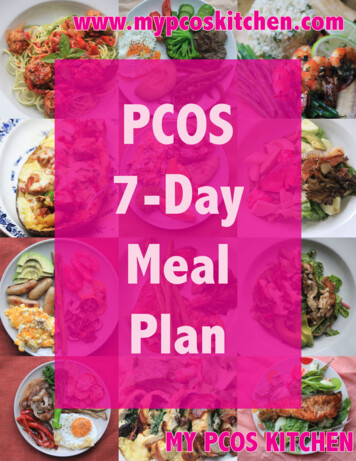

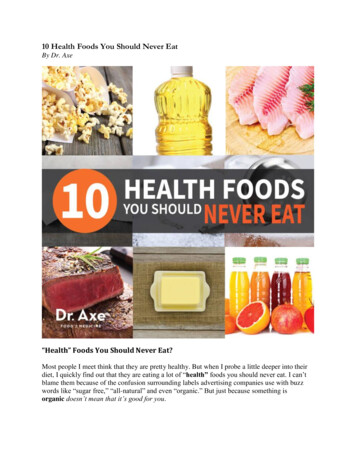
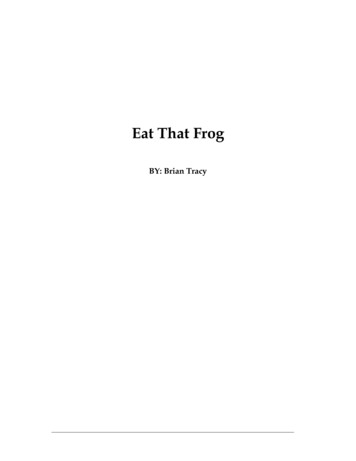
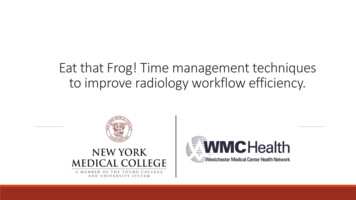
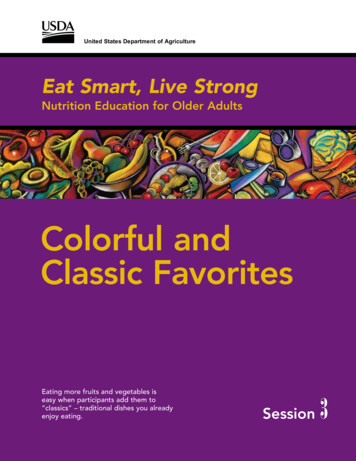

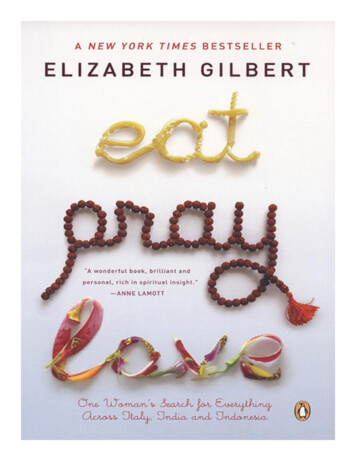
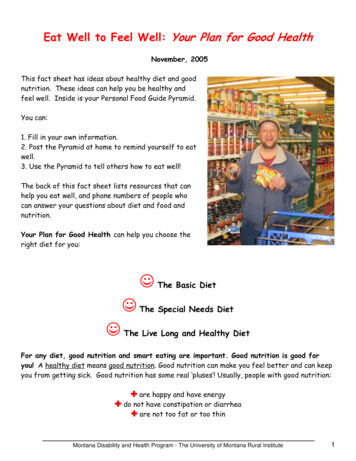
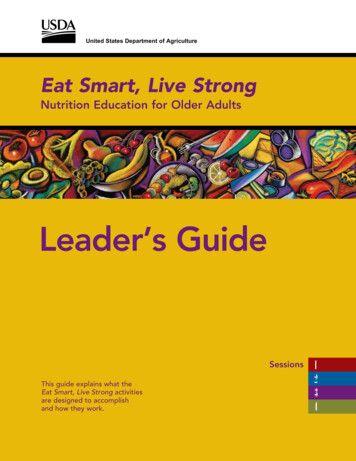
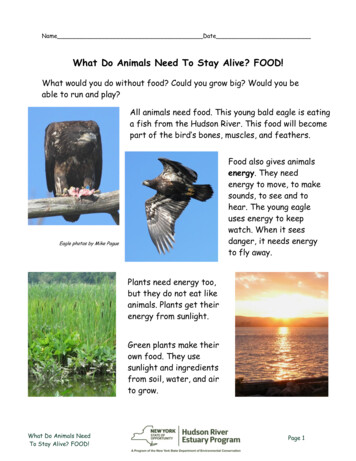
![[Page 1 – front cover] [Show cover CLEAN GET- AWAY 978-1 .](/img/13/9781984892973-6648.jpg)